Introduced in April of 2011, the Advantech ARK-1503 is part of Advantech's large lineup of embedded box IPCs. Embedded IPCs are a class of computers almost unknown to the public, but filling an important role in numerous industrial and embedded applications. In essence, IPCs offer conventional PC functionality in a compact, rugged enclosure. The computing power and connectivity of IPCs varies widely, ranging from legacy functionality and support all the way to state-of-the-art performance and implementation of the latest and most specialized standards. IPCs can be used stand-alone in applications where a conventional PC would not hold up, or they can be integrated (or "embedded") into larger systems. Where does the ARK-1503 fit in?
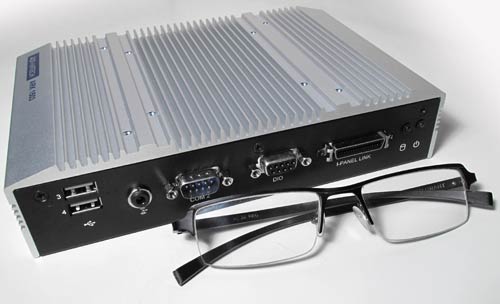 As a general purpose industrial PC for all sorts of projects, and also as part of special solutions in conjunction with Advantech's line of ITM industrial displays (more on that later).
As a general purpose industrial PC for all sorts of projects, and also as part of special solutions in conjunction with Advantech's line of ITM industrial displays (more on that later).
The picture to the right shows the ARK-1503, a system designed specifically for applications that require a compact, sturdy housing that'll fit in even the tightest places. The whole package measures about 9.1 x 5.25 inches and is only 1.75 inches tall. We put a pair of glasses in the picture to illustrate just how small and compact the ARK-1503 is.
Part of the reason why the ARK-1503 (and many others of Advantech's IPCs) can be so compact is because it does not need a fan. Internal heat generation from the processor and ancillary electronics is collected via heat spreaders and then dissipated through the heavy ribbed-fin external enclosure of the device. The external aluminum heat sink is a characteristic design element of these fanless PCs and also gives them a rather attractive, high-tech look.
Does this mean that compact fanless IPCs can only deliver modest performance? Not necessarily. That's because, unlike notebook or tablet computers, IPCs do not have to deal with heat generated from the display (they use external displays) or a battery (most run on external power). Further, since IPCs aren't carried around, weight doesn't matter much and so they can have larger and heavier heat sinks than would be feasible in a mobile device. The ARK-1503 still doesn't weigh much though, just 3.4 pounds.
Advantech's design goals for the ARK-1000 series of ultra-compact embedded IPCs is to provide targeted (i.e., just enough) but scalable performance in small, rugged and fanless enclosures covering a variety of interface requirements. For the ARK-1503 they chose the Intel Atom D425/D525, economical processors designed by Intel for low-end desktop applications. These chips were launched in Q2 of 2010 and represent slightly faster versions of Intel's second generation of Atom chips that replaced the original Atom 230/330
What's the difference between the D425 and the D525? Both run at 1.8GHz, but the D425 is a single core design with two threads whereas the D525 has two cores and four threads. Thermal design power isn't that different (10 vs. 13 watts), both chips have integrated graphics, and both are part of a two chip solution that includes the Intel ICH8M. For those who might be interested in how these chips differ from the original Atom D410/D510, the new D425/D525 CPUs have a slightly faster clock speed (1.8GHz vs. 1.66GHz) and use DDR3 memory that can transfer data at twice the rate of DDR2 memory used in the older processor, and with lower power consumption.
The image below shows the top view and all four side views of the ARK-1503. The housing consists of a steel chassis and the all-aluminum finned heat sink, and feels exceedingly solid. Despite the frugal Atom processors' low Thermal Design Power, the housing is essentially designed as one large heatsink to facilitate the fanless (and thus silent and more reliable) operation. Note the clean and purposeful design and execution that facilitates easy integration as well as painless maintenance.
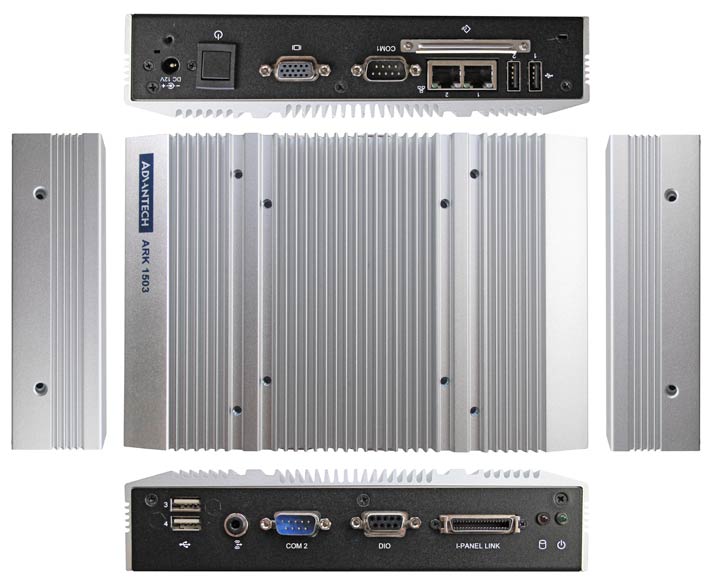
In terms of functionality and connectivity, this compact Advantech IPC was designed primarily for kiosk and factory/machine automation control applications. The ARK-1388 is configured to offer the following external ports:
- 4 x USB 2.0 (2 front, 2 rear)
- 1 x Serial RS232
- 1 x Serial RS232/422/485
- Digital IO
- 2 x RJ-45 gigabit LAN
- Antenna
- Power (DC 12 Volt)
- VGA video
- Audio out
- I-Panel Link (LVDS/HDMI/Display Port/UART/USB/Audio)
The ARK-1503 can either run off solid state storage medium via an externally accessible CompactFlash card slot, or via a 2.5-inch SATA hard disk that fits into the internal drive bay (max 9.5mm height). Our review unit used a 2GB Western Digital SiliconDrive II CF Card. The decision between Flash or hard disk will usually depend on the OS (the ARK-1503 supports Windows XP Pro, XP Embedded, Windows 7 and Windows CE 6.0) and application. The test unit was configured with a Transcend 2GB DDR3 13333 SODIM CL9.
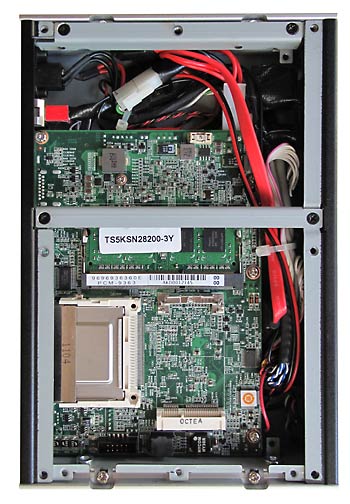 The inside of the ARK-1503 (see picture to the right) is easily accessible by removing the steel bottom plate of the unit that is held down by eight small Philips screws. This reveals the ARK-1503's motherboard and also provides access to the SODIMM memory slot and the mini-PCIe slot. Also visible are the SATA cables used for applications that use a hard disk instead of Flash.
The inside of the ARK-1503 (see picture to the right) is easily accessible by removing the steel bottom plate of the unit that is held down by eight small Philips screws. This reveals the ARK-1503's motherboard and also provides access to the SODIMM memory slot and the mini-PCIe slot. Also visible are the SATA cables used for applications that use a hard disk instead of Flash.
Those familiar with Advantech's lineup may also note a similarity of the ARK-1503's motherboard with the PCM-9363 SBC (Single Board Computer), with the exception that the ARK-1503's board has remote housing-mounted ports as opposed to the board-mounted ports on the SBC version.
For more information on the ARK-1503, peruse the PDF manual (see ARK-1503 manual here).
In terms of ruggedness, the requirements for an IPC are different than those of a mobile computer. The housing is tough and very sturdy, and designed to handle the kind of shocks and vibration that may be encountered by fixed-mount system. Operating temperature is -4 to 140 degrees Fahrenheit for units with "extended temperature peripherals," i.e Flash-based one. Hard disk based versions can handle a more modest 32 to 113 degrees Fahrenheit.
The computer fulfills a long list of EMC and safety requirements. Sealing against water isn't generally much of an issue for IPCs as they are usually mounted and used in secure environments.
Note that the ARK-1388 can be ordered in a ARK-1503F and a 1503P version. The primary difference is that the F versions (either Atom D425 or D525) have a DB36 LVDS (low-voltage differential signaling) interface that integrates LVDS/HDMI/Display Port/UART/USB/Audio signals whereas the P version (only available with the D525) has a 164-pin "golden finger" docking connector specifically for use of the ARM-1503P with Advantech's ITM-5115R-PA1E 15-inch LED-backlit industrial grade touch display (see here). This makes the ARK-1503P/ITM-5115 a complete all-in-one solution.
If the plug-in all-in-one approach is not needed, or projects require larger or smaller displays, Advantech also offers 12-inch and 17-inch versions of the ITM display. These can be connected via the 36-pin I-Panel link cable that combines touchscreen, power, backlight and LVDS into one.
The image below shows a possible kiosk use of the ARK-1503 that could be implemented wither with the I-Panel link or via the "golden finger" all-in-one interface.
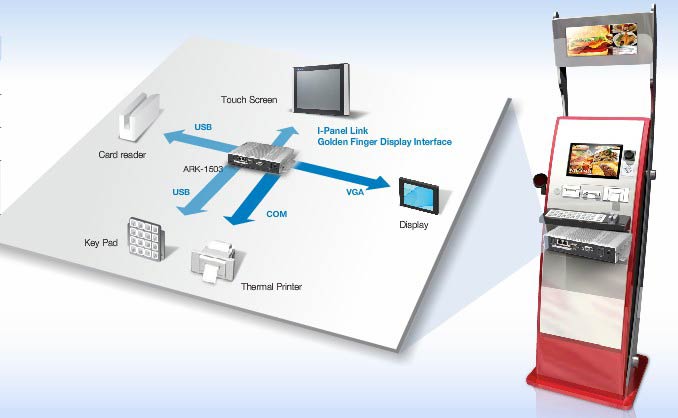
Bottomline: What an ultra-compact fanless IPC like the Advantech ARK-1503 offers is mainstream computing power and a wide variety of connectivity in a small, rugged package suitable for any number of systems integration projects or solutions in conjunction with Advantech's special industrial touch displays.
-- Conrad H. Blickenstorfer, June 2011
Advantech ARK-1503 Specs:



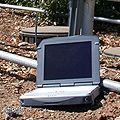


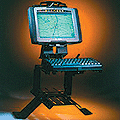





 As a general purpose industrial PC for all sorts of projects, and also as part of special solutions in conjunction with Advantech's line of ITM industrial displays (more on that later).
As a general purpose industrial PC for all sorts of projects, and also as part of special solutions in conjunction with Advantech's line of ITM industrial displays (more on that later).

 The inside of the ARK-1503 (see picture to the right) is easily accessible by removing the steel bottom plate of the unit that is held down by eight small Philips screws. This reveals the ARK-1503's motherboard and also provides access to the SODIMM memory slot and the mini-PCIe slot. Also visible are the SATA cables used for applications that use a hard disk instead of Flash.
The inside of the ARK-1503 (see picture to the right) is easily accessible by removing the steel bottom plate of the unit that is held down by eight small Philips screws. This reveals the ARK-1503's motherboard and also provides access to the SODIMM memory slot and the mini-PCIe slot. Also visible are the SATA cables used for applications that use a hard disk instead of Flash.
